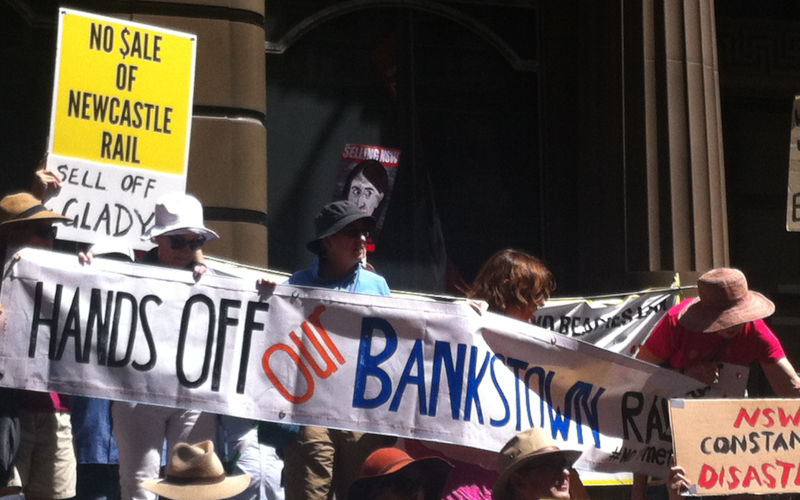There is little to celebrate in the Minns’ government commitment to the conversion of the Bankstown line to a metro – basically a train to nowhere but high-rise hell. Opposition to it from locals and community groups was dismissed by the greedy and the aspirational as NIMBYism, but our reasons lie in its genesis, and the dishonesty and ideology that progressed it.
Currently the T3 line from Central can take you to 27 stations through to Liverpool. The metro will have one new station after Central (Waterloo) but 16 stops will be lost – Redfern (important for Sydney Uni students), and all the stations beyond Bankstown. There is now an inquiry into Western Sydney’s current and future transport needs, but to what end? The Upper House Inquiry into the Bankstown line conversion recommended the metro stop at Sydenham – advice ignored by the current and past state governments. Labor under Daley promised to do this, and Jo Haylen, Sophie Cotsis and Jihad Dib, when in opposition, spoke against the project, cast as a Trojan Horse for privatisation.
In 2012, transport minister Berejiklian launched Sydney’s Rail Future, after “exhaustive and intensive research.” The evidence least supported a metro service in terms of benefit to customers, cost and the rail network in general. Specifically, it concluded that a dedicated metro system would not result in “service enhancement, capacity improvements or better operating efficiency” for the network; it would “ divert funding away from service improvements on the existing rail network”.
Rod Staples, meanwhile, had his own vision for a privately-operated metro, and MTR Hong Kong, with its “property plus rail” business model, was itching to enter the Australian market. For Staples, Berejiklian and Constance the metro idea ticked the neo-liberal boxes of privatisation, personal ambition and union-bashing. We were now supposed to believe that spending billions to replace an existing public rail service, with a private limited-seat metro with less reach, was great for commuters and the rail system. It was “a transformative project that Sydney cannot do without” wrote Staples in an opinion piece in the SMH in 2018. John Brew, former State Rail chief executive, and Dick Day, former urban planner and senior rail manager, disagreed: the Bankstown metro would be a long shuttle service which would not take pressure off the existing system and capacity benefits would not be realised, even if the corridor undergoes massive high-rise development. The sensible course would be to update the network’s signalling system, add a new underground city station and prioritise a metro to Parramatta.
An enormous propaganda campaign was used to justify the least effective, most expensive plan to enhance Sydney’s rail network: glossy brochures distributed by friendly Metro staff at stations, Metro school holiday programmes, and a Chanel 7 “documentary” The World’s Best Metro. After 300 submissions opposing the government’s plans were received from my small suburb of Hurlstone Park, Channel 7 ran a fake news story about us losing our railway station. The government had declared war on the people. It is no accident that the Bankstown line has far fewer services than every other route to the city (after Berejiklian reduced them). Commuters were going to beg for a metro.
The public has not seen the business case, nor contractual details; you can bet it will continue to cost us. Private consultants supported the government in Environmental Impact reports for the metro; heritage experts were unconcerned about plans to demolish multiple heritage-listed railway buildings and replace them with pre-fabricated pods: they concluded that the railway would retain its history as it was still going along the same route. The project is a money spinner for private interests, politicians, their mates and developers. It was recently revealed on the ABC that senior metro managers are running consultancy firms benefitting from multi-million-dollar metro contracts.
The conversion of the T3 line to metro has never been in the public interest. 90% of submissions opposed the project; the only “community group” which supported it was found out to be a front for developers. When a transport rally was arranged in the city in 2018, rail services were cancelled. The coalition government’s secretive and financially incompetent approach to major projects was repeatedly criticised by the state auditor. This project, to convert 13 railway stations, and lose access to 16, is costing billions of dollars – more than the total being spent on Snowy Hydro 2.0 and federal housing and extinction prevention funds.
This project is a top-down vehicle for developer-led planning. Baird laid the groundwork when he forcibly merged the Canterbury and Bankstown Councils. Developers have been given a discount to one percent of affordable dwellings in the Campsie master-plan. Meanwhile, we have a lack of hospital beds, school capacity, tree cover and green space. Development in our area has been a failure in affordability, sustainability, amenity and design; it attracts Maguires and Nassifs.
Minns and Haylen might be all smiles in spruiking the supposed benefits of the T3 conversion, but we’ve heard it all before. It’s the wrong metro, in the wrong place, for the wrong reasons. After much fanfare and billions spent, our rail network has been undermaintained, around half of all stations are not fully accessible, and losses are hidden in the Transport Asset Holding Entity. None of this bodes well for planning or public transport in the foreseeable future.

Marie Healy
Marie Healy helped to co-ordinate the formation of the Residents Action Coalition. Marie was instrumental in obtaining an Upper House Inquiry in the Metro Conversion of the Bansktown Line and in saving many of the heritage-listed railway buildings that had been marked for demolition. Marie lives in a Heritage Conservation Area, and around 6 years ago joined the NSW Greens.
